SIDNEY HENRY SNELGROVE
Lieutenant, 7th King's Royal Rifles Corps
Killed in Action at the Battle of Hooge, Belgium, 31 July 1915[1]
Buried at Sanctuary Wood, south of Hooge, in an unmarked grave
Commemorated at C Menin Gate, Ypres, Belgium, panel 51 and 53

Sidney Henry Snelgrove
(Image source: Imperial War Museums, Lives of the First World War)
Sidney Henry Snelgrove was born at Kingswood on the Pembury Road in Tunbridge Wells on 7 December 1891. He was the younger son of barrister John Sidney Snelgrove and his wife Gertrude Emily, née Chatteris. He had an older brother John Sidney Norman and an older sister Marjorie Gertrude, both born in Hampstead. It is unlikely that he ever lived in Forest Row, but owes his place on the memorial to the fact that his father was living at The Plottage, Ryst Wood, when material for the Forest Row memorial was being collated.
Sidney Herbert Snelgrove began his education at Hurstleigh Preparatory School in Holmhurst Close, Bishops Down in Tunbridge Wells. The building began as a Victorian mansion built around 1860 and became a private prep school around 1880. While there he was head of school and captain of the cricket and hockey teams. From Hurstleigh he went in 1905 to Rugby, where he was in Mr Brooke's House, in his house eleven and a signaller in the Officer Training Corps. He completed his education at Trinity College Cambridge where he was admitted as a pensioner on 25 June 1910. (Pensioners or commoners were students who paid for their own tuition and meals.)
The 1901 census shows Sidney with his family at Kingswood (though brother John is presumably away at school) in a household which included a governess and seven domestic servants, one of whom was a 'children's maid'. The 1911 census found the family — again without John — at the Torquay Hydro (pictured below), presumably on holiday, with Mrs Snelgrove supported by a single ladies' maid. Sidney is listed as a student.

(Click to enlarge)
The Torquay Hydro began life as Villa Syracusa and belonged to the Romanoff family. By 1890 it had become a convalescent home for Boer War soldiers, but the home closed in 1901 and the property became a hotel, in which guise it remained until 1939. Then it became the offices for the Prudential Insurance Company for the duration before returning to life as a hotel.
When war broke out, he was training to be a chartered accountant, but on 21 November 1914 Snelgrove was gazetted 2nd Lieutenant in the 14th Battalion King's Royal Rifle Corps, and on 2 February the following year became Lieutenant in the 7th Battalion. He didn't arrive in France until 16 July and was killed only 15 days later, on 30 or 31 July[2] 1915. It seems that the Casualty List for 1 August was lost, which may explain the confusion over dates. A note in the Forces War Records reads:
Listed as 'casualty in the Expeditionary Force reported from General Headquarters under date 1st August missing' on the Casualty Lists issued by the War Office from 7th and 8th August 1915.
Snelgrove had been leading his platoon under heavy shell fire in the support of another company during a counter-attack at the Chateau Hooge. The Rugby School Roll of Honour describes the situation Snelgrove found himself in:
At Hooge, on the 29th and 30th of this month, the trenches were attacked by liquid fire and taken by the enemy. Attempts to recapture them were made all through the 30th and 31st. Lieutenant Snelgrove was sent with his Platoon to the support of another Company, under heavy shell fire, when he fell...
In this action, of which no official account was given at the time, the 8th Rifle Brigade lost 21 Officers, and the 7th Rifle Corps 13. There were 63 Officer casualties in all.
It seems particularly hard that he was killed so soon after his arrival in France, although his early death no doubt spared him much unpleasantness. His commander, Lieutenant Colonel Rennie, wrote:
He was leading his men splendidly at the time.
while his erstwhile commander from the 14th Battalion described him as:
...one of my smartest officers. I was quite sure he would distinguish himself when he went to the Front.
The UK register of soldiers' effects issued £53 14s 9d to his administratrix and noted that there were no local debts outstanding. His sister-in-law, Ethel Marian Adelaide Snelgrove, was granted probate on 5 April 1916, with the deceased described as:
Sydney Herbert Snelgrove of Kingswood Tunbridge Wells and the Golfers Club Whitehall Middlesex
Effects were valued at £1,514 6s 1d. Presumably there was unfinished business, as his niece, Mary Georgiana Betty Duval, was made a further grant of probate in 1939, with the effects slightly reduced at £1,468 6s 4d.
Sidney had qualified for the 1914-15 Star medal on 17 July 1915, but presumably didn't live long enough to receive it. His father applied for it in respect of his late son on 18 August 1919 from his Forest Row address, though an alternative in Bournemouth was also given.
Sidney's mother died in 1919, presumably before the Commonwealth War Graves Commission had completed their work, as she is consistently referred to in documents as the late Gertrude Emily Snelgrove. His father, still living at The Plottage, died in 1940. Both parents are buried at Tunbridge Wells cemetery** where they are commemorated on a mosaic ledger stone. It is said that Sidney's mother threw herself into war work after his death and that her own was brought on by a broken heart at the loss of her son. Marjorie never married, and died in Crawley in 1975. John Sidney Norman Snelgrove fought during World War I in the Royal West Kent Regiment and died at Richmond in 1963.

Tunbridge Wells War Memorial
(Click to enlarge)
With thanks to the Royal British Legion for their excellent website.Courtesy of http://www.roll-of-honour.com/Kent/TunbridgeWells
Like many men of his class, Sidney Herbert Snelgrove's name appears on a number of different memorials. As well as the Menin Gate and the Forest Row memorials, he is commemorated at Tunbridge Wells Town memorial and at St James' Church, Tunbridge Wells — both on the Lych Gate and on a plaque inside the church. The plaque reads, partially:
In loving and proud memory of Sidney Henry Snelgrove...Killed in Action when leading his platoon Under heavy shell fire... Aged 23 years.
St James' Church Tunbridge Wells
(Click to enlarge)
In Rugby School Chapel a tablet in the floor reads as follows:
THEY WHOM THIS CHAPEL COMMEMORATES WERE NUMBERED AMONG THOSE WHO AT THE CALL OF KING AND COUNTRY LEFT ALL THAT WAS DEAR TO THEM, ENDURED HARDNESS, FACED DANGER, AND FINALLY PASSED OUT OF THE SIGHT OF MEN BY THE PATH OF DUTY AND SELF-SACRIFICE, GIVING UP THEIR OWN LIVES THAT OTHERS MIGHT LIVE IN FREEDOM. LET THOSE WHO COME AFTER SEE TO IT THAT THEIR NAME BE NOT FORGOTTEN
In Trinity College Cambridge the inscription reads, in Latin:
These all died in faith, not having received the promises, but having seen them afar off, and were persuaded of them, and embraced them, and confessed that they were strangers and pilgrims on the earth. (Hebrews 11:13)
Pam Griffiths
26 January 2017
Updated 20 July 2020 & 9 January 2022
1) Some sources indicate that Lieutenant Snelgrove died on 30 July, not 31 July. [^]
2) Information supplied by the Friends of Tunbridge Wells Cemetery. [^]



